
Deep Sea Vent Communities: Did Life Originate in the Abyss?
Scientists have long assumed that life on Earth originated in the oceans and the recent discovery of communities of microbes and animals that congregate around hot spring vents in the deep sea has buoyed speculation that the earliest life on our planet may have occurred in the depths of the ocean in the absence of sunlight. Deep Sea hot spring vents are places on the seafloor where hot water exits the ocean crust and comes to the surface. The hot water forms when seawater is heated in young ocean crust (usually close to spreading centers and areas of volcanic activity). Associated with these vents are living communities that exist thousands of meters beneath the surface of the sea, first discovered them in the late 1970's. Up to that time it had always been assumed that life required sunlight, but we now know the communities that live near these deep sea vents can exist on thermal and chemical energy provided by the vent. Thus, there life does not necessarily need sunlight and photosynthesis to prosper.
Oceans have existed, more or less, since the beginning of Earth's history. Life on the bottom of the oceans is actually well protected from variability on the surface of the Earth (climate variations etc.), and thus some scientists think that these deep sea hydrothermal vents might be the most ancient sites of life on Earth. Although their discovery does by no means imply that life originated in the depths of the oceans, these deep sea vents are nonetheless an alternative site.
Scientists that believe that hydrothermal vents were the cradle of life argue that the mix of high heat and cold seawater in the vent environment led to the formation of the first organic compounds, and that the formation of pyrite in ancient vents from sulfur and iron could have produced energy to force organic compounds to combine, leading eventually to the creation of life. In this context it has been proposed that metal sulfides of black smokers (one type of deep sea vent) could act as catalysts in the first step toward building organic molecules (remember, polymerization on mineral surfaces is also implicated in early RNA catalysis). Some scientists now believe that life in hydrothermal vents began well before 3.2 billion years ago. Using electron ionization mass spectroscopy, they found few differences when they compared organic compounds from current vents with biologically diverse vents fossilized in 3.2-billion-year-old greenstone from South Africa.
Hydrothermal vents in the deep oceans provide a fascinating view into a part of our
planet that was only vaguely imagined a quarter-century ago and is still not well
understood today. Beyond their intrinsic interest, vents may play an important role
regulating the temperature and chemical balance of the oceans; help us investigate
the origin of life on our planet and elsewhere in our solar system; and are a potential
source of recoverable resources (the are base metal deposits in the making).
 |
| Hydrothermal circulation occurs when seawater penetrates into the ocean crust, becomes heated, reacts with the crustal rock, and rises to the seafloor. Seafloor hydrothermal systems have a major local impact on the chemistry of the ocean that can be measured in hydrothermal plumes. Some hydrothermal tracers (especially helium) can be mapped thousands of kilometers from their hydrothermal sources, and can be used to understand deep ocean circulation. Because hydrothermal circulation removes some compounds from seawater (e.g. Mg, SO4) and adds many others (He, Mn, Fe, H2, CO2), it is an important process in governing the composition of seawater. |
Geochemists theorize that all the water in the world's oceans is recycled through
hydrothermal vents once every 6 - 8 million years in a process called hydrothermal
circulation. Water seeps into cracks in the ocean's crust, is heated by magma, and
eventually reemerges through a hydrothermal vent. It loses magnesium (Mg) and sulfide
(SO4) and gains metals such as copper (Cu), iron (Fe), manganese (Mn), zinc (Zn), and
sulfur (S) on its journey. It is estimated that the amount of water that passes
through deep ocean vents each year is on the same order of magnitude as the annual flow of
the Amazon River.
Hydrothermal circulation has an impact on the temperature and chemical balance of the
oceans. It removes magnesium and sulfate from seawater, and adds calcium, potassium, gases
such as hydrogen sulfide and methane, and trace metals such as iron and manganese. Until
the discovery of hydrothermal vents, scientists had believed that the chemical balance of
the oceans was determined primarily by run-off from the continents. Now run-off and
hydrothermal infusion are thought to be equally important.
Vent fluids containing microbial cells as well as gases rise from the ocean floor for tens
to hundreds of meters to eventually become diluted plumes spread horizontally by the
currents. Scientists have detected effects of hydrothermal vents 1000 kilometers (621
miles) and farther away from their source on the Juan de Fuca Ridge off the coast of
Oregon(tracing helium). Megaplumes can form quickly, within a matter of hours, and
are often associated with volcanic activity and a shifting of the Earth's tectonic plates.
A vent that opened in February, 1996 produced a plume of hot water, minerals and microbes
that was 9.66 km (6 mi.) wide.
Black Smokers and Other Vent Features
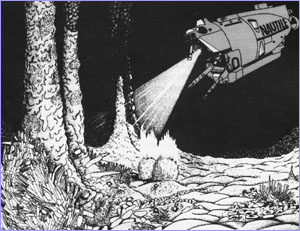 |
The best known vent features are the so-called black smokers, hot springs that belch out black "smoke" (actually the precipitation of metal sulfides (pyrite mostly) in the vent waters). They were discovered by specialized submersibles that can operate at great depth. Sulfide precipitation at the vent produces chimney-like structures as seen in the picture at left. |
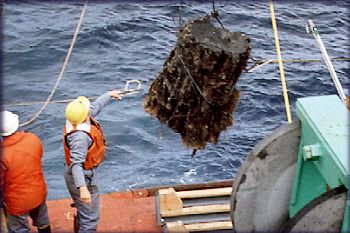 |
Pieces of these black smokers have been cut off by the submersible and hoisted to the surface for further study. They were still steaming, covered with microbes, and crawling with life. |
| A black smoker vent on top of a 10 m high chimney, with a temperature of 342°C (Marker 12, VENT1 at South Cleft, Juan de Fuca Ridge). This one is just chugging along like an old fashioned steam engine. Click on link for video. | |
 |
This sulfide chimney is located in the CASM vent field (Juan de Fuca Ridge), where Axial volcano's north rift zone enters the caldera. Click on link for video. |
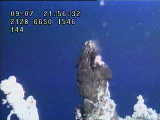 |
Bubbles of gas can be seen escaping from this hydrothermal chimney. This is an unusual sight in the crushing pressure of 2200 pounds per square inch at this depth of 1500 meters! (Juan de Fuca Ridge) Click on link for video. |
Living at Extremes
If there is a harsher place to live than a hydrothermal vent, it hasn't been
found yet. Pitch darkness, poison gas, heavy metals, extreme acidity, enormous pressure,
water at turns frigid and searing -- this seafloor environment seems more like something
from deep space than from our own deep sea.
Yet amazing communities of life exist at hydrothermal vents and the so-called "black
smoker" chimneys that, given the right conditions, rise above them like erupting
stalagmites. Blind shrimp (evolved from shallow water species with eyes?) , giant white crabs, and a variety of tubeworms are just some of the
more than 300 species of vent life that biologists have identified since scientists first
blundered upon this otherworldly community two decades ago. More than 95 percent of these
species are new to science.
It's hard to say which is more remarkable to scientists studying this bizarre world
thousands of feet beneath the sea: what these animals have to cope with, or what they have
come up with to do that coping.
For starters, it's pitch black at such depths. Sunlight penetrates no farther than a few
hundred feet down, leaving the deep-sea floor as dark as the deepest cave. With no
sunlight, there are no plants; all vent life belongs to the animal kingdom. And with no
plants, there is no photosynthesis. Biologists were amazed when they first learned that
creatures lived in total darkness at the seafloor. All other life ever identified, on land
or in the sea, derives its energy either directly or indirectly from the sun. How, they
wondered, did these animals manage without?
Through chemosynthesis, it turns out. Vent species rely not on photons from the sun but on
chemicals from the Earth's interior. Tiny microbes oxidize the hydrogen sulfide that
diffuses out of the vents, providing nutrients for animals higher up the food chain. Some
creatures, such as the mollusks known as gastropod snails, feast on the bacteria directly;
others, including predatory fish, dine on animals that have eaten or otherwise made use of
the microbes; still others, like tubeworms, host the microorganisms in their tissues in
exchange for organic compounds that the bacteria fashion from the vent chemicals and
seawater. (The only element from above that these microbes require for their artistry is
oxygen, which is abundant in seawater and was originally produced, of course, by plants.
So when it comes right down to it, even these life forms ultimately rely on sunlight.
The food chain of the chemotrophs begins with Hydrogen Sulfide, a chemical that is released at hydrothermal vents. Normal sea water contains sulfate, a stable form of sulfur unusable by the chemosynthetic bacteria that make up the base of the food chain at a hydrothermal vent. The sulfate is transformed chemically into hydrogen sulfide when sea water is super heated to temperatures well over 300 degrees C. Water can only exist as a liquid at these temperatures because of the enormous pressure present at 2500m. Chemosynthetic bacteria use hydrogen sulfide as an energy source instead of sunlight. These bacteria are then fed upon by giant clams, mussels, polychaete worms and other invertebrates forming the base of the food chain. The clams and tube worms do not live at the hydrothermal vents due to the great heat. However, they can never survive too far away from their food source. These invertebrates are in turn fed upon by crabs and octopuses. Life at a "smoker" is precarious at best. The hydrothermal vent's very existence is controlled by the movement of the tectonic plates. As a plate shifts it creates new "smokers" and can close off old ones. If the new vent is not close enough to the old one, the community will perish, since most of the invertebrates are sessile benthos (they have attached themselves to the rocks around the vent and can not move). Despite this hazardous temporary existence and lack of habitat (as measured by surface area) the animals that live at hydrothermal vents have changed and evolved over time as well as spread from ocean to ocean. In a study reported in the journal Nature in Feb. 1996, over 40% of Atlantic ridge fauna also exist in the Pacific Ocean. This suggests that these creatures spread along the ridges when the ridges were connected around the southern tip of South America. Finding these incredible communities living without light has shows that life will always find a way.
Life does not only thrive on the surface near these vents, but also at depth where the hot hydrothermal waters are circulating. Bacterial biomass is actually ejected from these vents, although not from those that are at the upper end of the temperature scale (400 degrees C).
 |
A pulse of hot water and microbes from the subsurface biosphere. (Juan de Fuca
Ridge) Click on link for video. |
 |
This is a view of "Magnesia Vent", a site where microbial flocs are coming
out of the seafloor like from a snowblower! (Juan de Fuca Ridge) Click on link for video. |
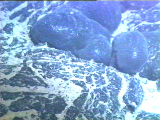 |
A view of freshly erupted vs older lava. The new lava is black and glassy and
not covered with sediment and microbial colonies (white). The new lava erupted at
Axial Volcano in January 1998 (Juan de Fuca Ridge). Click on link for video. |
A snowblower vent at the CoAxial FLOC site spews bacterial flocs into the water. A 1993 dike intrusion produced a bloom of bacteria here in the "subsurface biosphere". (Juan de Fuca Ridge) Click on link for video. |
A toxic brew As if utter darkness were not enough, vent animals must contend
with a witch's cauldron of deadly toxicants. Foremost among them is hydrogen sulfide, one
of the principal ingredients of the broiling water spewing from vents and black smokers.
While vent microbes thrive on the stuff, this gas is lethal to most other organisms,
including the creatures that live within wafting distance. Yet not only do those animals
survive it, they depend on it as intrinsically as they do on the microbes. Hydrogen
sulfide reacts spontaneously with oxygen, so as soon as vent fluids come into contact with
seawater, a swift reaction occurs, releasing energy. All that energy would go to waste if
it were it not for the microbes. They harness that reaction and use carbon dioxide to make
organic compounds that tubeworms, for example, need to live.
Heavy metal and acid rock Vents and smokers also release a bevy of heavy
metals. Besides being toxic substances, these particles can clog mouthparts and gills.
Biologists are still trying to figure out exactly how vent animals cope with these.
Several animals have metal-binding proteins in their systems, while others, like some
polychaete tubeworms, appear to expel these toxins in mucus. Beyond the toxic gas and
particles, vent water can also be extremely acidic. The pH of waters coming out of black
smokers can be as low as 2.8, making it more acidic than vinegar. Biologists have seen
"naked" snails around hydrothermal vents that could not form their calcium
carbonate shells because the water was too acidic. Below are some pictures and video
clips of these hot spring colonists.
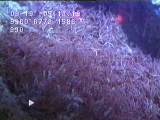 |
Palm worms are named for the fact that they look like tiny palm trees. These palm
worms are flourishing in the CASM vent field at the base of a hydrothermal chimney. (Juan
de Fuca Ridge) Click on link for video. |
 |
A newly discovered species of scale worm that had already colonized a the new lava
flow in August 1998 (see above)! It appears to graze the microbial mat covering the new
lava flow. (Juan de Fuca Ridge) Click on link for video. |
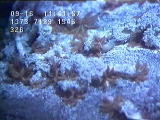 |
A close up view of sulfide worms fighting each other for territory on the side of a
vent chimney! (Juan de Fuca Ridge) Click on link for video. |
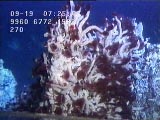 |
These tube worms live in the CASM vent field. When the front of the submersible bumps
into them, you can see them retreat into their tubes. Tube worms are one of the most
common and recognizable species that live at hydrothermal vents. (Juan de Fuca Ridge) Click on link for video. |
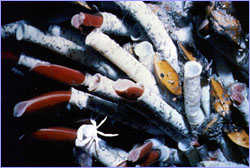 |
A closeup of a tubeworm colony. Tubeworms host the microorganisms that metabolize sulfides in their tissues in exchange for organic compounds that the bacteria fashion from the vent chemicals and seawater. They also live on organic matter from microbial flocs that get spewed into the water by the hot springs |
 |
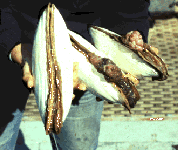 |
At left, a colony of large clams that colonize a hot spring mound. Like the tubeworms, these clams host the microorganisms that metabolize sulfides in their tissues in exchange for organic compounds that the bacteria fashion from the vent chemicals and seawater. They also live on organic matter from microbial flocs (clams are filter feeders) that get spewed into the water by the hot springs. At right examples of these large clams that have been brought to the surface. |
Life on Other Planets
Some astrogeologists and astrobiologists expect to find life-incubating
hydrothermal vents on other planets where there are, or were, both liquid water and
volcanic activity. Mars and Jupiter's moon Europa are two good candidates. NASA's Galileo
spacecraft has sent back photos of intriguing patterns on Europa's surface. To some
scientists, the patterns appear to be similar to new crust on our planet's Mid-Ocean
Ridge, while others interpret them as evidence of ice flow on a liquid sea that may be
above a hot, rocky interior. Liquid water plus hot rocks are likely to equal hydrothermal
vents.
Considering that oxygen seems to be needed for the operation of modern vent ecosystems,
and assuming that the early oceans were reducing until enough oxygen had been produced
through photosynthesis, it appears that although it is intriguing to think of hot springs
as sites of the early evolution of live, they must have originated later. However,
ancient vent ecosystems may have operated differently and may not have needed oxygen.
Recent work on the evolution of bacteria also suggests that the thermophile
bacteria that are the foundation of vent communities are not the most ancient
bacteria. The oldest common ancestor seems to
belong into a group known as the Planctomycetales
that are not known to be thermophilic. The thermophilic lifestyle of vent
bacteria seems to be a secondary adaptation. Stay tuned.